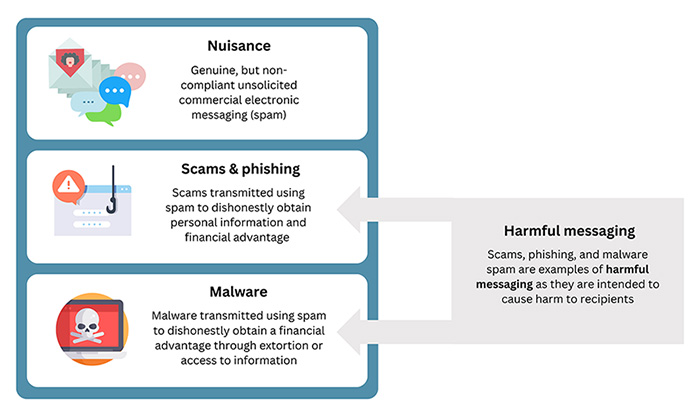What is spam?
Spam, also referred to as unsolicited electronic messages, is any unwanted email, fax, SMS TXT, or other instant message that is commercial by nature.
New Zealand’s Unsolicited Electronic Messages Act 2007 is a piece of legislation design to prevent spam and create a safe and secure electronic environment for businesses and communities. Although there are many forms of communication that may be considered spam, the Act is only concerned with commercial unsolicited messaging.
Commercial messages
Commercial messaging includes the promotion or marketing of goods and services. The promotion of ‘free’ products or services is included as they still meet the definition of goods and services, regardless of cost.
Some messages may be exempt from being considered an unsolicited commercial electronic message. This includes messages that:
- Facilitate, complete, or confirm a commercial transaction
- Provide warranty information, product recall information, or safety or security information about goods or services
- Provide notification of factual information about a subscription, membership, account, or loans
For a full definition of commercial electronic messages and a list of exempt messages, see section 6 of the Act.
Some businesses or Internet Service Providers (ISPs) may include a clause in their contracts or terms and conditions that allow them to send promotional or informational messages about your account. Ensure you read all terms and conditions carefully.
Message Functionality
The Act covers various aspects related to the functionality of a commercial electronic message, this includes:
- Ensuring the message contains a functional unsubscribe facility within the message
- Ensuring the message contains information about the sender, more specifically, the identity of the sender and how recipients can readily contact them
Different types of spam
We break spam down into three categories – nuisance, scams and phishing, and malware.
Scams, phishing, and malware messages are examples of ‘harmful messaging’ because they intend to cause harm to recipients. Although nuisance spam messages are non-compliant, they are not examples of harmful messaging because they do not intend to cause harm to recipients. See below for a breakdown of the three categories.

Scams
Spam messages may also be scams, which are messages designed to defraud you, for example, by pretending that you have won a lottery or been left an inheritance.
It’s important to remember that scammers want you to reply or act from their message. Some will pretend to be from well-known businesses, include links they want you to click, or ask you to login to an account. Some may even include malicious software to spy on you, hijack your accounts and contacts, or use your computer or device for malicious purposes, such as sending further scam messages.
If you believe you have encountered a scam, see our how to report scams page for advice and information.
Use the button below to report spam and scams.